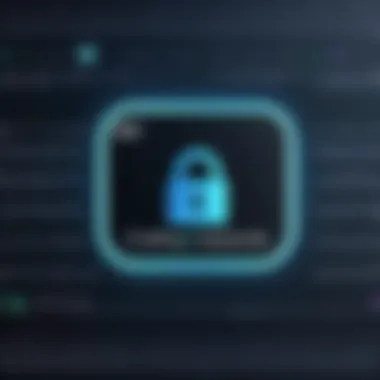Crafting Effective Passwords: A Comprehensive Guide


Intro
In today's ever-evolving digital environment, the role of effective password management cannot be overstated. Addresses the necessity for secure online practices is crucial, given the staggering number of data breaches every year. Preventing unauthorized access is not only about having strong passwords but also integrating various security strategies to form a comprehensive defense. Crafting effective passwords is the vital first step in this multifaceted endeavor.
Cybersecurity Threats and Trends
The landscape of cybersecurity is rife with dangers that continue to complicate digital security for individuals and organizations.
Notable Cybersecurity Threats in the Digital Landscape
Cyber adversaries are increasingly exploiting vulnerabilities for nefarious ends. Phishing attacks remain pervasive, embedding themselves imprudently into various email platforms or social media channels. Ransomware is also a significant threat; attackers lock users out of their systems, demanding substantial payment for re-access—a devastating trend both personally and commercially.
Emerging Trends in Cyber Attacks and Vulnerabilities
As technology evolves, attack methods become more sophisticated. Machine learning enables threat actors to experiment adaptive strategies. Furthermore, the surge in remote work has expanded the attack surface, making it easier for them to penetrate systems. Cybercriminals are now targeting endpoints, relying not solely system loopholes, but also on human error.
Impact of Cyber Threats on Individuals and Businesses
The consequences of these threats are significant. For individuals, a data breach can lead to identity theft or financial loss. Businesses face not only monetary costs but also reputational damage that lingers afterward. Each compromised system results in a costly refurbishment process, and the aftermath can often detour businesses into legal liabilities and scrutiny.
Best Practices for Cybersecurity
To fortify one's online presence, adhering to benchmarks of strong password management is paramount.
Importance of Strong Password Management
Creating unique, complex passwords for different accounts cannot be overstated. Risks of repeated passwords leave users vulnerable. Accessible password managers can facilitate this by securely storing varied user data across platforms.
Implementing Multi-Factor Authentication for Enhanced Security
Multi-factor authentication serves an additional protective layer, prompting users to verify their identity through a separate means, such as generating a code or confirming through an app. By layering authentication methods, accounts are less likely to fall prey to automated breaches.
Regular Software Updates and Patches for Protection
Staying current with software updates is a necessary habit. Developers regularly release patches that address security vulnerabilities. Regular Tommy updates can mitigate numerous risks and block systems from being overly affected by hacks exploit fatal flaws flaw in outdated software.
Secure Online Browsing Habits and Email Practices
Practice caution when browsing the web and opening emails. Educational resources on recognizing fraudulent contacts can empower users. Knowledge is the first step to safeguarding sensitive data in interactions and encounters online.
Privacy and Data Protection
With endless information sharing on the web, privacy and data protection become critical realities.
Importance of Data Encryption for Privacy
Data encryption helps shield private information. Whether deploying it in an organizational environment or individually, encrypting sensitive files offers a guaranteed level of confidentiality. Only receive devices and sanctioned personnel can access encrypted data.
Risks Associated With Sharing Personal Information Online
Excessive social media activity might lead to overexposure. Accidental or intentional sharing opens windows for unwanted intrusion. Targeted phishing scams typically stem from publicly available data, making awareness in data matters each user's responsibility.
Strategies for Safeguarding Sensitive Data and Personal Details
Regular audits on information shared online revaluate please ensure current privacy settings meet an individual’s goal. Removing unnecessary data retention spots inconsistencies here is crucial and updates necessary assess track record and dominancy - two-pronged approach secures personal data.
Security Technologies and Tools
Various technologies and tools play supporting roles in cybersecurity measures.
Overview of Key Cybersecurity Tools and Software
Antivirus software remains the first line of defense. Tools like Norton and McAfee provide users with the means to fight against digital threats, offering substantial security layers. Similarly, firewalls act as a barrier( cowd separating property) preventing external access when configured properly.
Benefits of Using Antivirus Programs and Firewalls
Antivirus programs diligently scan the machine for threatening patterns and mitigate infected files found t be.' etsa running. Firewalls bet elliptic come to hydration monitoring opportunities documents recruiting tense monitoring prevent attempts unauthorized out■erk.


Application of Virtual Private Networks (VPNs) for Secure Data Transmission
VPNs encrypt internet connections and conceal the user's IP address, establishing secure channels for data transfer--vital not just in the workplace but also when individuals operate under unsecured Wi-Fi networks.
Cybersecurity Awareness and Education
The foundational requirement for securing digital spaces rests in grooming awareness among users.
Educating Individuals on Recognizing Phishing Attempts
Phishing attacks can trick well-meaning users. Comprehensive education programs, illustrating common tactic and insertion lessons, can help larger communities undermine their effectiveness.
Promoting Cybersecurity Awareness in the Digital Age
Creating a culture of cybersecurity awareness proves essential; simple practices and compliance can prompt substantial lead toward body.recip данным imposto effectiveness positive behavior against algorithms robot younger.
Resources for Learning About Cybersecurity Fundamentals
Educational institutions, local communities, and online workshops often provide resources for personal improvement concerning cybersecurity. Sites such as en.wikipedia.org and britannica.com host some information I näher videos, as also forem, automation, particularly hjælp overall identification methods conflict mitigation, thus esconsult helpful too anticipating documented services or libraries.*
Prelims to Password Security
Crafting secure passwords is a foundational element of cybersecurity. In an age where online activities have burgeoned, the need for robust password practices becomes crucial. A password acts as a gateway to sensitive personal and professional information. Hence, understanding aspects of password security should be priority for every user navigating the digital realm.
Understanding the Importance of Passwords
Passwords serve as the first line of defense against unauthorized access. A strong password can effectively deter attackers and safeguard one's digital identity. Passwords authenticate users, ensuring that only legitimate users can access specific accounts and data. Thus, it is essential to prioritize password strength and management.
Key considerations include:
- Prevention of Unauthorized Access: Weak passwords can easily be guessed or cracked using various methods, leaving your accounts vulnerable.
- Protection of Sensitive Data: Passwords not only protect personal information but also, in professional settings, company secrets. A breach can have far-reaching consequences.
- Legal Responsibilities: Companies sometimes face liabilities in case of data breaches due to poor password practices. Adoptive good practices mitigate risks.
=> By recognizing the vital role passwords play in cybersecurity, we can begin developing techniques for creating stronger passwords.
Common Cybersecurity Threats
Understanding the landscape of cyber threats is essential when discussing password security. Several typical threats can exploit inadequate password practices:
- Phishing Attacks: These attacks aim to deceive users into providing credentials by posing as legitimate entities.
- Brute Force Attacks: Attackers employ automated systems to guess passwords. For weak passwords, this is often alarmingly easy.
- Keylogging: Malicious software captures input from users. If a password is captured this way, it's compromised instantly.
Each of these threats underscores the danger posed by weak password practices. Users must implement strong, complex passwords alongside other security measures to mitigate these risks. Understanding such vulnerabilities equip users with practical ways to strengthen their online safety.
Defining a Strong Password
Defining a strong password is not just a recommendation; it is a necessity in today’s increasingly digital world. The landscape of cyber threats continuously evolves, making it vital for users and businesses to safeguard their sensitive information from unauthorized access. A strong password serves as a frontline defense against an array of security breaches, from simple hacking attempts to sophisticated phishing schemes. Understanding what constitutes a strong password can significantly enhance your online safety, ensuring that account infiltration becomes a daunting task for potential intruders.
Characteristics of Strong Passwords
Strong passwords share certain characteristics that prevent unauthorized access. Here are some key elements that should be incorporated:
- Length: A strong password should be at least twelve characters long. Longer passwords exponentially increase the difficulty for hackers to crack them.
- Complexity: Incorporating a mix of uppercase letters, lowercase letters, numbers, and special symbols can significantly enhance password strength. This variety frustrates automated cracking tools since they rely on predictable patterns.
- Unpredictability: Avoid common words or easily accessible personal information. Utilizing random combinations of characters or strings of unrelated words reduces the chance of a successful attack.
In essence, the primary goal is to create passwords that are hard to guess yet memorable enough for users.
“A password should be like shampoo instructions: don’t share, keep it secret, and choose strong components.”
Using these characteristics allows individuals and organizations to define what a strong password truly encompasses. Focusing on these elements is an effective starting point in our quest to create a well-guarded online identity that resists intrusions.
Length and Complexity Requirements
One of the fundamental criteria for crafting a strong password is its length and complexity requirement. Cybersecurity experts recommend that users create passwords that are both long and diverse in character usage. The longer a password is, the harder it becomes for covert systems to crack it.
Length
- A minimum of twelve to fifteen characters are suggested. This length will significantly increase difficulty against brute force attacks.
Complexity
To elevate complexity, aim to construct passwords that blend various character types, specifically:


- Uppercase Letters (A-Z)
- Lowercase Letters (a-z)
- Numbers (0-9)
- Special Characters(List like @, #, $, %, &, *)
This variation constitutes a stronger resistance against automated guessing routines and dictionary attacks. Therefore, integrating both length and complexity, while steering clear of easily available information, remains essential for every individual seeking to secure their personal and professional data against the pernicious threats of cyberspace.
Techniques for Password Generation
Generating secure passwords is crucial for all users who engage with online platforms. A robust password can act as the first line of defense against unauthorized access to personal and sensitive information. This section outlines two effective methods: using passphrases and random password generators.
Using Passphrases
Passphrases are an effective way to create strong passwords. A passphrase consists of a sequence of random words, making them easier to remember while providing strong security. For example, instead of using
The Role of Password Managers
Password managers have emerged as essential tools in the realm of digital security. They assist users in generating, storing, and managing their passwords effectively. In today's complex cyber landscape, where numerous websites and services require unique credentials, the responsibility of maintaining strong password hygiene can become overwhelming. This is where password managers play a pivotal role.
Using a password manager addresses the problem of password fatigue. Many users resort to reusing passwords or creating simple, easy-to-remember passwords out of convenience. Unfortunately, this practice opens doors to breaches as it compromises security across multiple platforms. A reliable password manager mitigates these risks by enabling users to create, store, and access complex passwords effortlessly and securely.
Benefits of Using a Password Manager
- Centralized Storage: Password managers consolidate all your passwords in one secure location. Instead of jotting passwords down haphazardly or hoping to remember them all, users only need to remember one master password. This reduces the cognitive load significantly.
- Enhanced Security: Many password managers utilize advanced encryption methods to protect user data. This means your passwords are cloaked from potential interceptors, thereby preventing unauthorized access.
- Password Generation: A good password manager includes features that generate strong, unique passwords on demand. This saves time and enhances security by ensuring that no two passwords across the same service are the same. Different sites require different layers of strength.
- Automatic Filling: User convenience is another significant aspect. By automatically filling in login forms, password managers reduce the likelihood of typos or phishing attempts, enhancing overall security. You simply navigate to a website and let the manager do its work.
- Alerts and Monitoring: Many password managers monitor known data breaches and alert users if their credentials are compromised. This proactive feature empowers users to take immediate action, such as changing their passwords or exploring additional security measures.
Using a password manager may seem like an additional step, but it drastically improves password security and your overall online safety.
Popular Password Manager Options
Choosing an appropriate password manager can be subjective based on user needs and preferences. However, several options have gained attention within the cybersecurity community:
- LastPass: Known for its user-friendly format, LastPass allows for extensive password sharing and reporting tools, making it a strong choice for families or businesses.
- 1Password: It features robust security and allows team sharing and multiple vaults. This option is often favored by those in want of greater teamwork online.
- Dashlane: Offers additional features like a dark web monitoring service. Ideal for users who want extensive insights into their personal security landscape.
- Bitwarden: A notable open-source password manager, Bitwarden has received significant acclaim for its transparency and regular updates.
By incorporating password managers into your routines, managing an array of unique, strong passwords becomes more feasible. The choice of which password manager depends on specific needs but harmonizing convenience with security elevates the overall posture against cyber threats.
Implementing Two-Factor Authentication
In the landscape of cybersecurity, implementing two-factor authentication (2FA) marks a significant enhancement to password security. It integrates an additional layer of defense that goes beyond the conventional single-password mechanism. This approach mitigates the risk associated with unauthorized access, offering a wiser and more robust protocol for safeguarding sensitive information.
What is Two-Factor Authentication?
Two-factor authentication is a security measure that requires two separate forms of identification for verification when accessing an account. The first factor is typically a password, while the second factor can take the form of something the user has (like a smartphone) or something the user is (such as a fingerprint). This measure enhances the overall security practically in two ways:
- Increased Security: Even if an attacker compromises the password, they would still need the second factor to gain access.
- User Awareness: Making users aware of attempts to log in from non-registered devices boosts vigilance against unauthorized access.
Modern platforms often provide various types of second factors, such as time-based one-time passwords (TOTPs), SMS codes, or authentication apps like Google Authenticator.
How It Enhances Security
The implementation of 2FA significantly improves security in several ways:
- Reduction of Fraud: Attackers have a harder time breaching accounts that require two forms of identification. It essentially doubles the difficulty in compromising an account.
- Real-Time Alerts: Users often receive notifications for login attempts that can deter unwarranted access. This immediate awareness can prompt action, like changing passwords or reporting suspicious activities.
- Phishing Resistance: Even if a hacker acquires login credentials, they face barriers repeatedly. Most phishing attempts fail because individuals do not possess the second authentication factor.
- Comprehensive Security: Incorporating 2FA complements other measures like using robust passwords and changing them regularly. This multifaceted approach shields users more effectively and addresses various threats in the digital space.
Two-factor authentication is not just an option; it is an essential security protocol for anyone navigating the online domain today.
In summary, the incorporation of two-factor authentication acts as a formidable barrier against potential cyber threats, while continuing to educate users about the security of their digital lives. This argument for 2FA makes a compelling case for adoption among professionals in IT and cybersecurity, as well as anyone consumnig online services.
Monitoring Password Health
Monitoring password health is a critical aspect of maintaining online security in today's ever-changing cyber environment. It involves an ongoing assessment of the strength and effectiveness of passwords used across various platforms. By regularly evaluating password health, individuals can take proactive steps to prevent unauthorized access to their accounts and sensitive data.
Regularly Updating Passwords
Password longevity poses significant security risks. Outdated passwords can become weak over time, especially when they are illicitly exposed in data breaches. Regularly updating passwords can provide a fresh layer of security and mitigate potential risks.
- Best Practice: Changing passwords every three to six months is a reasonable period.
- Methods for Updates: Consider using a system based on personal timelines. Update passwords on your birthday or during notable occasions. This approach helps avoid confusion and follows a natural routine.
Moreover, significant life events, such as this:
- Switching jobs
- Experiencing fraud
- Receiving news of a data breach involving your accounts
These events are natural indicators for reevaluation of your password strategy. By sustaining a current password database, you increase your account's resistance to attacks.


Identifying Compromised Passwords
An effective approach to password management involves identifying compromised passwords swiftly. Compromised passwords can emanate from several sources, notably data breaches that compromise popular services. It is crucial to check if your passwords are part of known data leaks.
There are tools for this task, such as:
- Have I Been Pwned
- Security features built into renowned password managers like LastPass.
Once an account's password is suspected to be breached, immediate action should be taken. Best practices include:
- Changing the compromised password immediately.
- Enabling notifications for any unusual activity in the account.
- Conducting a thorough review of other accounts using the same password.
Maintaining awareness of password health can make a substantial difference. It empowers individuals and organizations to react promptly to potential threats. Proper hygiene will strengthen not only personal accounts but contributes significantly to broader organizational security integrity.
Common Pitfalls in Password Management
Password management is a crucial component of digital security. Many individuals and organizations fail to recognize common pitfalls, which increases vulnerability to cyber attacks. Addressing these pitfalls is vital to fostering a culture of security that prioritizes effective password practices.
Reusing Passwords Across Platforms
Reusing passwords is a widespread issue that puts users at greater risk. When people use the same password across multiple accounts, they simplify their lives but create a major security flaw. If a single account is compromised, it can open the floodgates to other accounts where the same password is also used. Breaches can occur on platforms like Yahoo or LinkedIn. Once reached, hackers have access to valuable information, creating a chain reaction of compromises.
To avoid this, each account should have a unique password. This adds complexity to password management but greatly enhances security. While it may be difficult to remember long passwords for every service, using a password manager helps in this regard. Considering the potential risks enhances awareness and drives changes in behavior.
Weak Password Recovery Questions
Another common pitfall involves weak password recovery questions. Often, users select questions that are easily guessable or searchable. For instance, questions like "What is your mother’s maiden name?"
Infomation such as mothers’ marriage is often available through simple online searches, making these security measures ineffective.
To protect against this, users should take a more strategic approach by creating custom or non-standard answers that only they would know. Alternatively, employing multi-factor authentication can elevate security. Learning about effective strategies for password recovery is just as important as creating a strong password in the first place.
Understanding these pitfalls is essential for both individuals and IT subjects. Recognizing areas of improvement can directly mitigate the risks resulting from password management failures. It is ultimately about creating layers of defense in a domain where password vulnerabilities can have extensive implications on personal and organizational data integrity.
The Impact of Social Engineering
The significance of social engineering in the realm of cybersecurity cannot be overstated. This deceptive practice targets the human element, bypassing technical defenses through manipulation and persuasion. Understanding how these techniques are employed is crucial for individuals and organizations alike. A solid grasp of social engineering helps in safeguarding sensitive information and bolstering overall password security.
Understanding Social Engineering Techniques
Social engineering encompasses various tactics that cybercriminals use to obtain information deceitfully. Some common techniques include:
- Phishing: This involves sending emails that appear legitimate to deceive individuals into giving sensitive information such as passwords.
- Pretexting: In this method, attackers create a fabricated scenario to initiate contact with their target, gaining trust and eventually extracting confidential data.
- Baiting: Individuals are tempted with treated goods (often malware via USB drives) that, when engaged, lead to data breaches.
Detecting these techniques is challenging due to their clever design. Successful social engineering often relies on the target's lack of awareness or caution regarding their online security practices. It is vital to cultivate skepticism in online interactions and actions.
“Navigating online environments with vigilance minimizes opportunities for attackers.”
Protecting Against Manipulation
To shield against social engineering, thorough education and vigilance are essential. Here are steps individuals and organizations can take:
- Security Awareness Training: Regularly educate all personnel about different social engineering tactics. Tools like colleced examples can raise awareness.
- Two-Factor Authentication: Implement dual-factor authentication that requires an extra step beyond password input, making unauthorized access much harder.
- Verification of Requests: Always verify unexpected requests for sensitive information through direct contact, rather than replying directly to an email.
- Strong Password Policies: Enforce strict policies for password creation and management, reducing predictability. Encouraging unique passwords across platforms is fundamental.
By fostering a culture focused on vigilance and education, organizations can effectively reduce rates of manipulation via social engineering while enhancing the overall strength of their cybersecurity protocols. Regular reviews and updates of practices reinforce ongoing commitment to security, essential in a dynamically evolving threat landscape.
Ending: Best Practices for Password Security
Preserving the integrity of personal and organizational digital assets necessitates a nuanced understanding of password security. This conclusion synthesizes key practices that are indispensable for safeguarding accounts against potential breaches. By being mindful of specific elements such as password complexity, the use of password managers, and the implementation of two-factor authentication, users can cultivate a robust defense against unauthorized access.
Summary of Key Points
An effective security strategy hinges on several cornerstone practices:
- Unique Passwords: Each account should have its own distinct password. This mitigates risks associated with password reuse.
- Longer Passwords: Favor length over brevity. Aim for a minimum of 12 characters, mixing letters, numbers, and symbols.
- Password Managers: Employ tools like LastPass or 1Password for creating and storing intricate passwords securely, negating the need for memorization.
- Two-Factor Authentication: Whenever feasible, activate two-factor authentication to add a protective layer beyond mere passwords.
- Regular Updates: Change passwords periodically and as soon as potential threats emerge.
- Stay Informed: Watching for breaches and security news, assists in proactively addressing security vulnerabilities.
Adherence to these practices can significantly reduce the likelihood of falling prey to cyberattacks and identity theft, ultimately fostering a safer digital environment.
Future Considerations in Cybersecurity
As technology evolves, so do the methodologies employed by cybercriminals. Examination of upcoming trends is critical. Key factors that will shape the course of password security in the near future include:
- Biometric Authentication: Increasing reliance on biometric verification as a norm could alleviate dependency on passwords, although debates on privacy will ensue.
- Artificial Intelligence: Rising utilization of AI in deciphering passwords emphasizes the need for continuous password evolution.
- User Education: As cyber threats become more sophisticated, elevating cybersecurity awareness will be paramount.
- Convergence of Security Protocols: The trend towards integrating multiple forms of authentication into a seamless single sign-on experience will continue, fostering greater security but require consumer buy-in.
By addressing these considerations and adapting strategies correspondingly, both users and organizations can sustain a resilient posture against evolving cyber threats.







